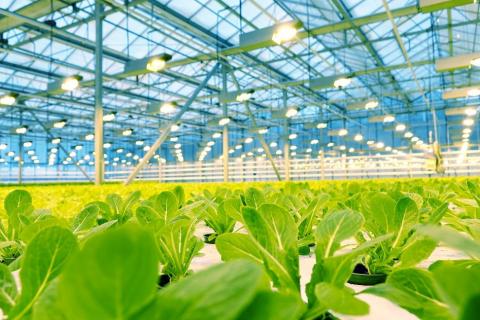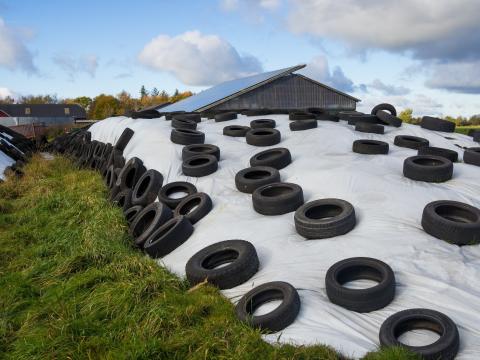10 June 2020
Dr David Cutress: IBERS, Aberystwyth University.
- Agricultural infrastructure has multiple areas where direct and indirect greenhouse gas emissions can occur
- On-farm infrastructure as well as national/global level infrastructure both act as areas of potential GHG emissions
- Infrastructure is vital to the operation of the agricultural sector as a whole. However, its impact on climate change appears to be a low priority in the UK
Recent figures suggest agriculture accounts for around 10% of the total GHG emissions in the UK and up to 24% of all human-related GHG emissions globally, indicating that it is an area of significant climate impact. The main focus on emissions within this sector revolves around methane (CH4) production (mostly enteric production in livestock) and nitrous oxide (N2O) production (mostly through applications of inorganic fertilisers). Previous figures have suggested the emissions of these to be fairly similar due to agricultural outputs with around 25 million tonnes of carbon dioxide equivalent being emitted every year. Whilst these are now key targets they are not the only climate impacts associated with agriculture, several other emission factors exist which need highlighting and mitigating for. One such area is agricultural infrastructure.
What is meant by infrastructure
Within agriculture, infrastructure relates to the basic systems, facilities and services required to keep the sector operating: power supplies, communication systems and transportation methods, as well as, farm buildings, processing buildings and storage units. Infrastructure can be considered either broadly across the sector or on the level of an individual farm. Whilst significant infrastructure is imperative for the sector to thrive, aspects of its development, running and maintenance are significant contributors to greenhouse gas (GHG) emissions, both directly and indirectly.
Current areas of emissions
Agricultural buildings
Due to increasing demands on agricultural production to supply a growing population, there has been a global shift towards increasing production using controlled, protected environments. The ability to accurately control environments within these buildings whether these are crop production facilities (including aquaponics and heated greenhouses) or livestock buildings (e.g. poultry and pig rearing units) achieves far more consistent conditions for optimal growth and yield. However, such systems also require significant energy inputs, acting indirectly to increase GHG production. One regular source of GHG emissions is the construction of farm buildings. Whilst it is difficult to ascertain precise figures for these emissions, it is suggested that their influence is present but fairly minimal. Figures from 2018 place emissions from construction throughout the whole of the UK at 2% of the country’s total and agricultural buildings will account for only a fraction of this.
Livestock
Levels of GHG production also vary depending on livestock being farmed. A significant UK study of the energy consumption per sector was performed in 2007. This suggested that within each sector; poultry egg/meat production, pig production and dairy farming (figure 1), significant energy was required for lighting, ventilating and heating buildings. Dairy building-related energy inputs were further increased by energy requirements for cooling milk, heating water and operating milking machinery. The majority of energy consumption across beef and lamb production, however, was related to oils/diesel used for field operations or pasture maintenance and feeding.
Figure 1 Primary energy inputs into livestock sectors taken from 2007 report to DEFRA
Horticultural crops
When it comes to UK horticultural crops, one of the main inputs of energy is the use of greenhouses and other temperature-controlled buildings. Energy inputs include the use of ventilation, hot water circulation, cooling, heat pumps, air re-circulation and lighting. Within the group of edible crops produced in the UK, tomatoes had the highest energy consumption followed by cucumbers and peppers as these products need warmer temperatures to be maintained for improved yields and growth. Interestingly, figures from 2006 suggest that whilst protected crops account for a significant amount of energy input, due to the different energy mixes involved (mainly gas rather than electricity), compared to other aspects of agriculture its total contribution to carbon dioxide (CO2) specific emissions is only 0.1% (not accounting for GHG produced by refrigerated storage and transport). Using tomatoes as an example, a comparison of Spanish vs UK grown products suggested that due to increased inputs required for growth in the UK these tomatoes had >3x more CO2 impact.
Arable crops
Whilst the majority of arable crop GHG emissions are directly related to their growth; additions of fertilisers and chemicals for growth and the machinery used for their dispersal and harvesting, there are still direct agricultural building-related GHG emissions. Factors involved include the variable-temperature storage spaces for drying grain crops, as well as, ventilated or cooled storage conditions required for longer-term storage of mainstay crops such as potatoes. Each of these utilises energy, either directly from the grid or through the combustion of fuels and, therefore, acts to increase GHG emissions.
Irrigation
Irrigation for crop growth is of far greater concern in more arid countries. However, there is still an energy input and therefore passive GHG emissions contributing to UK statistics, particularly in sandy soil environments. This can be seen in the evaluation of sugar beet production, where irrigation accounted for almost 9% of all the energy/fuel consumption required for crop culture operations. Whilst currently irrigation is generally seen as nonessential in the UK, there are increasing concerns regarding future climate variation. As drought is becoming more regular, irrigation may become more commonplace and models are already being developed to aid farming enterprises in planning for such eventualities.
Agricultural machinery and vehicles
Mechanisation and vehicle use in agriculture has direct effects on GHG emissions, particularly CO2 through fuel combustion, accounting for around 11% of the total GHG emissions of the sector. There are also inherent GHG emissions associated with the initial construction of these machines/vehicles as well as in their continued maintenance and repair over their lifetime.
Transport through supply chains
Following on-farm production, there are yet further energy consumptions and GHG emissions which come into play through the remainder of the food supply chain. These include:
Transport
Produce is transported from farm to processing plants or direct to consumers/retail outlets with an estimated 10% of the total farming and fishing CO2e emissions being related to food freight in the UK (2013). Within this output 25 - 40% of the emissions are due to the need for on-board refrigeration in heavy goods vehicles (HGVs) and up to 21% of this fraction is linked to leakage of refrigerants such as hydrofluorocarbons (HFCs). Whilst there are direct mitigation strategies which can be put into place, it is suggested that the biggest factor (accounting for around half of all transport-related emissions of fruit and vegetables) is our reliance on air freight transport, which accounted for two-fifths of all transport emissions in the UK.
Processing
Primary processing can include; milling, malting and slaughtering and have been suggested to account for >23% of carbon dioxide equivalent (CO2e) emissions for the farming and fishing sector (2013). Further insight into the energy use in this sector finds 68% is used for heating (either processes or spaces), 16% for powering motors, 8% for further electrical heating, 6% for refrigeration and the remainder to power air compressors. However, certain processes (dairy product processing, meat processing and manufacture of bread and alcohols) are known to be responsible for higher emissions, reportedly accounting for four-fifths of all processing emissions.
Waste
Food waste as well as non-recycled packaging and agricultural plastic waste, all have influences on the sector's total GHG emissions. Any waste nullifies benefits being gained on the GHG emissions used in initial production, processing and transportation. Based on recent figures for the UK, 9.5 million tonnes of food is wasted annually and this is associated with 25 million tonnes of CO2e emissions or 5.5% of the total emissions from the UK (based on figures from 2018). With regards to non-recycled packaging waste from food production, figures suggest between 6 and 8 million tonnes of CO2e emissions or 1% to 1.7% of the total UK emissions (dependent on total emission values for the year of prediction). These figures have demonstrated a trend of increase in total % emissions over time. These increases are likely related to the trend of net reductions of UK wide emissions across all sectors, as well as a net trend of increasing waste production. Finally, direct farm-level agricultural plastic waste is a known issue. Whilst in many instances these plastics should be recyclable, many are considered hazardous due to their use in agrochemical storage which complicates recycling procedures with increased energy required for decontamination. As of 2012, the European recovery rate for agricultural plastics was 49.5%. Unfortunately, burning may be considered by some as a last resort despite the fact it is illegal due to the related production of dangerous pollutants as well as direct GHG production. Currently, in the UK there are a severely limited number of plants available to process this type of waste which may well lead to increased GHGs being produced in transporting waste to such facilities or less recycling occurring altogether.
Whilst infrastructure may play an important role in the functionality of the agricultural sector as a whole, and adaptations thereupon could improve emission levels through several adaptation/mitigation strategies, it is interesting to note that this aspect does not feature in DEFRA’s proposed ten indicators of GHG emissions and attitudes for England. This may well suggest it is an area that is being neglected despite the possibility that mitigations here could benefit sector outputs on the whole.
Summary
Infrastructure for the agricultural sector is vital to ensure efficient production, however at both farm and national levels it can have significant impacts in producing GHGs. Several key areas have been studied for their direct and indirect climate impacts over the years, including aspects such as agricultural building outputs, irrigation and transport. Whilst it is clear all of these areas have some detrimental impact on the environment there appear to be a far lower level of concern for such factors, with focuses instead being placed on methane production from livestock and nitrogen from fertilisers as key areas requiring mitigation.




